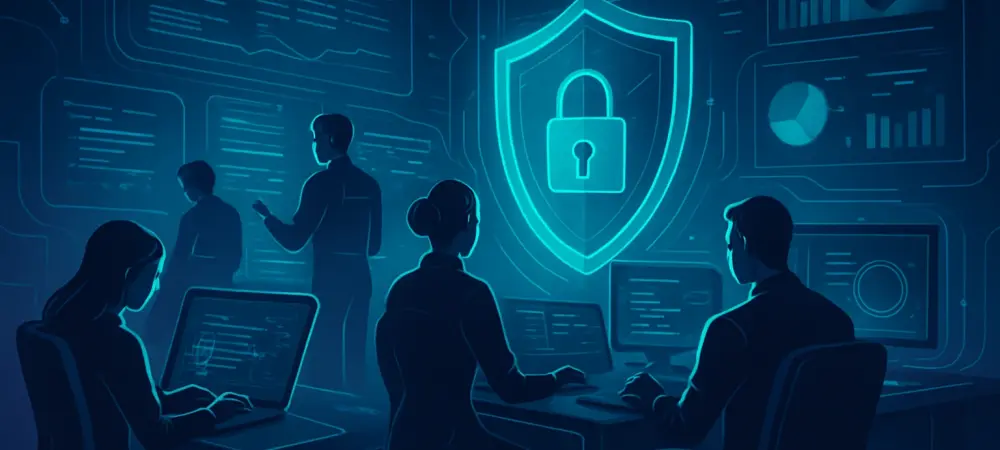Introduction to a Growing Concern
Imagine a corporate landscape where efficiency reigns supreme, yet every streamlined process inadvertently opens a door to digital disaster, posing significant risks to lean organizations. In today’s business environment, lean organizations—those prioritizing minimal staffing for maximum output—face a staggering reality: the average cost of a data breach in the United States has soared to $10.22 million. This figure, coupled with the alarming statistic that 86% of breaches involve stolen credentials, paints a dire picture for companies operating with reduced resources. As digital threats escalate, the intersection of downsizing and cybersecurity becomes a critical battleground. This analysis delves into the challenges faced by lean operations, examines real-world impacts, gathers expert insights, explores future implications, and distills key takeaways for navigating this precarious terrain.
The Surge of Lean Operations and Mounting Cybersecurity Hurdles
Escalating Risks Amid Workforce Reductions
Corporate downsizing has emerged as a dominant trend, with major players across industries slashing headcounts to boost efficiency. Prominent firms like Wells Fargo and Verizon have led the charge, reflecting a broader shift toward leaner structures that prioritize cost savings. However, this drive for minimalism comes at a steep price in the cybersecurity realm. According to IBM, the average time to contain a breach stands at 292 days, a delay that becomes even more perilous with smaller teams. The financial toll is equally staggering, with breach costs averaging $10.22 million in the U.S., and incidents involving hardcoded secrets adding an extra penalty of $750,000, pushing potential damages beyond $11 million.
The strain on security teams in such environments cannot be overstated. With developer-to-security staff ratios already unsustainable, lean organizations struggle to maintain robust defenses. Reduced manpower often translates to slower detection and response times, leaving systems vulnerable for extended periods. This vulnerability amplifies the risk of credential-based attacks, which dominate the threat landscape and exploit gaps left by overstretched personnel.
Tangible Impacts of Limited Resources
Real-world incidents underscore the dangers of operating with constrained teams. Take Canva’s experience, where a leaked secret led to significant downtime, disrupting operations and eroding trust. Similarly, the Singularity attack on GitHub compromised thousands of credentials, exposing the fragility of digital assets in understaffed settings. These cases highlight how a single breach can spiral into widespread damage when resources for rapid containment are scarce.
Delayed incident response in lean environments often triggers cascading effects. Prolonged exposure to threats not only increases the likelihood of data loss but also disrupts critical operations, leading to reputational harm. The lack of personnel to swiftly address breaches means that even minor lapses can balloon into major crises, with recovery timelines stretching far beyond initial expectations.
Moreover, the remediation of secrets poses a unique challenge compared to standard vulnerabilities. Unlike typical code fixes, addressing compromised credentials demands intricate cross-team coordination and deep infrastructure knowledge. This complexity turns what should be a straightforward task into a resource-intensive ordeal, further taxing already limited staff in lean organizations.
Expert Insights on Tackling Cybersecurity in Lean Settings
Industry leaders and Chief Information Security Officers (CISOs) consistently point to the unsustainable imbalance between developers and security personnel in downsized firms. The consensus is that traditional approaches, reliant on sheer manpower, fail to address the scale of modern threats. Many experts argue that the focus must shift from merely identifying risks to executing precise, effective solutions that maximize impact with minimal effort.
Thought leaders advocate for a departure from reactive, volume-driven detection methods toward strategies that emphasize precision in remediation. This pivot is seen as essential for aligning security efforts with the efficiency goals of lean operations. By honing in on actionable insights rather than overwhelming teams with alerts, organizations can better manage risks despite reduced headcounts.
A recurring theme among experts is the urgent need for innovative tools and automation. Platforms that integrate seamlessly into existing workflows and provide contextual data are hailed as game-changers. Such solutions not only reduce the burden on security teams but also enhance response capabilities, ensuring that lean organizations can safeguard their assets without compromising on operational agility.
Future Prospects for Cybersecurity in Streamlined Environments
Looking ahead, advancements in cybersecurity tools hold immense promise for lean organizations. Enhanced platforms, such as those inspired by GitGuardian’s model, are expected to prioritize contextual insights and workflow integration, enabling teams to address threats with greater accuracy. These tools aim to cut through the noise of false positives, potentially saving significant costs—often in the range of $500,000 annually—and streamlining manual tasks that currently drain resources.
Adopting precision-focused remediation offers multiple benefits, including faster response times and reduced financial burdens. By minimizing wasted effort on irrelevant alerts and automating repetitive processes, organizations can allocate their limited resources more effectively. However, challenges persist, including resistance to adopting new technologies and budget constraints that may hinder implementation, particularly in industries heavily reliant on digital infrastructure.
The broader implications of these trends are twofold. On an optimistic note, successful adoption of automation could lead to a stronger security posture, even in resource-scarce settings. Conversely, failure to adapt risks exacerbating the severity of breaches, with potential costs and disruptions reaching unprecedented levels. Balancing these outcomes will be critical for organizations aiming to thrive in an increasingly digital landscape.
Final Reflections and Strategic Steps Forward
Reflecting on the past, the convergence of lean operations and cybersecurity risks painted a challenging picture for many organizations. The financial stakes, with credential breaches potentially costing over $11 million, underscored the urgency of addressing these vulnerabilities. Limited staffing often meant prolonged exposure to threats, amplifying both direct damages and indirect losses through operational disruptions.
Moving forward, the path became clear: CISOs needed to rethink incident remediation by embracing precision-focused strategies that leveraged automation. Investing in tools that offered actionable insights and reduced manual overhead emerged as a vital step to protect against evolving threats. As the digital landscape continued to shift, organizations that prioritized such innovations positioned themselves to navigate future uncertainties with resilience and foresight.

